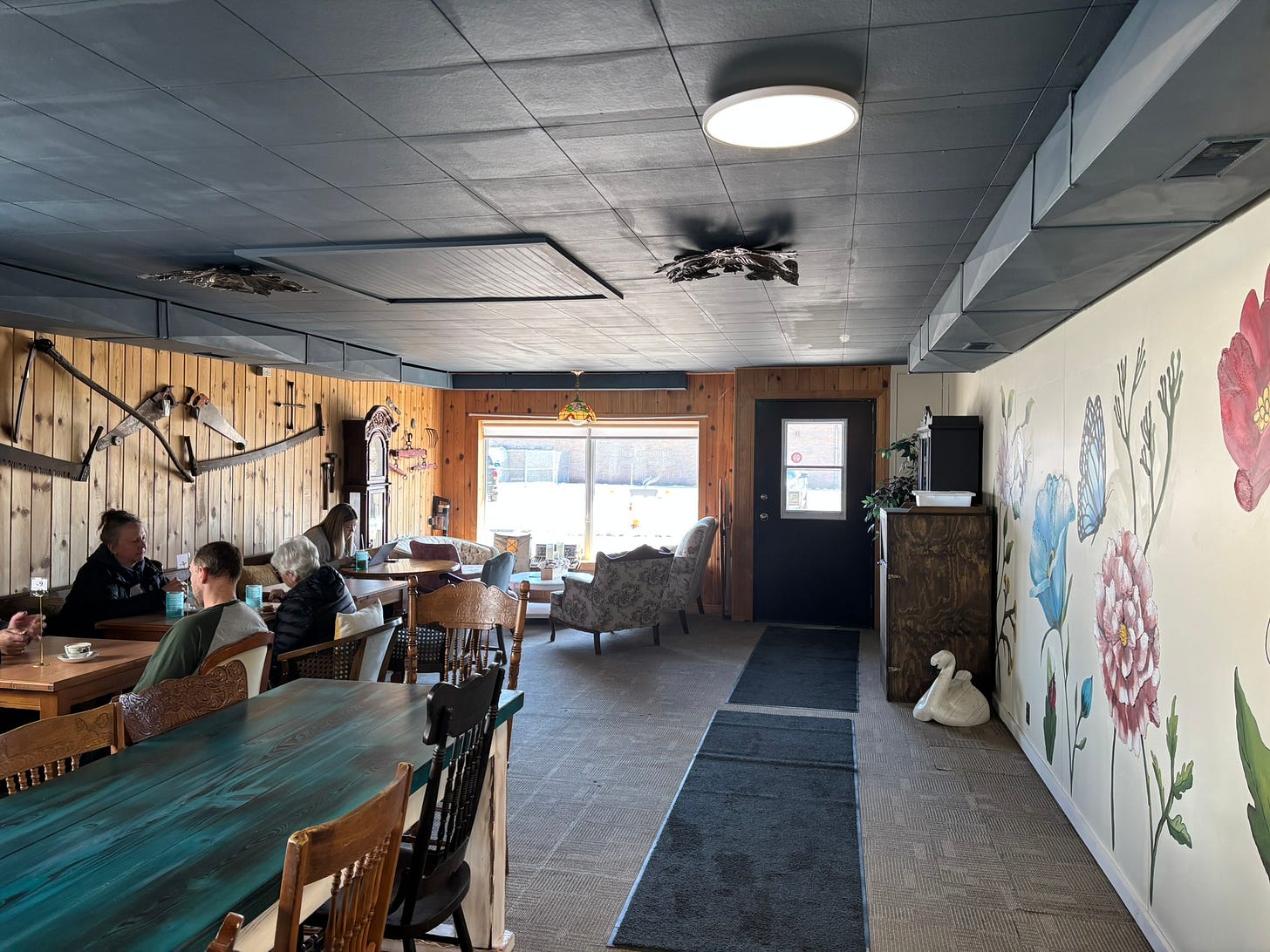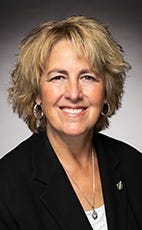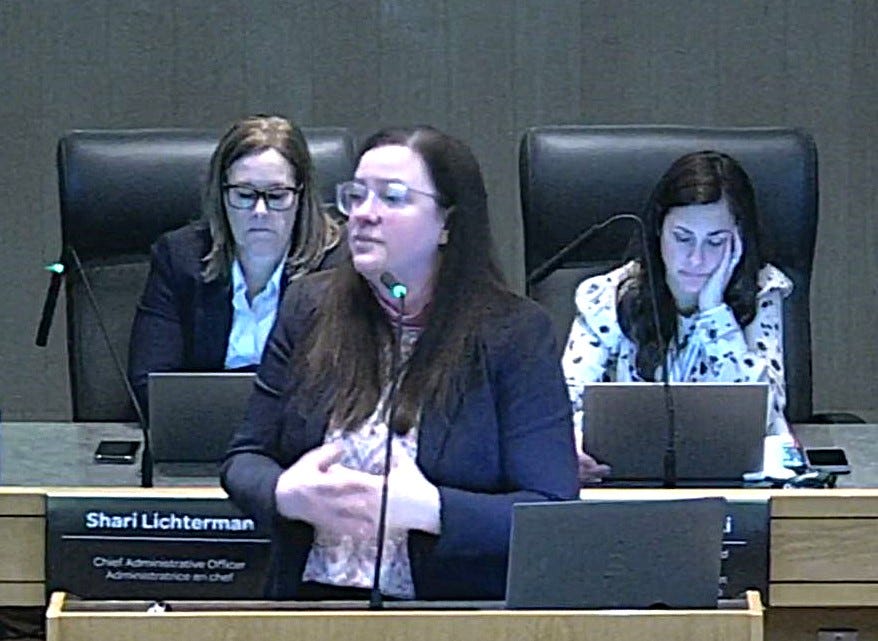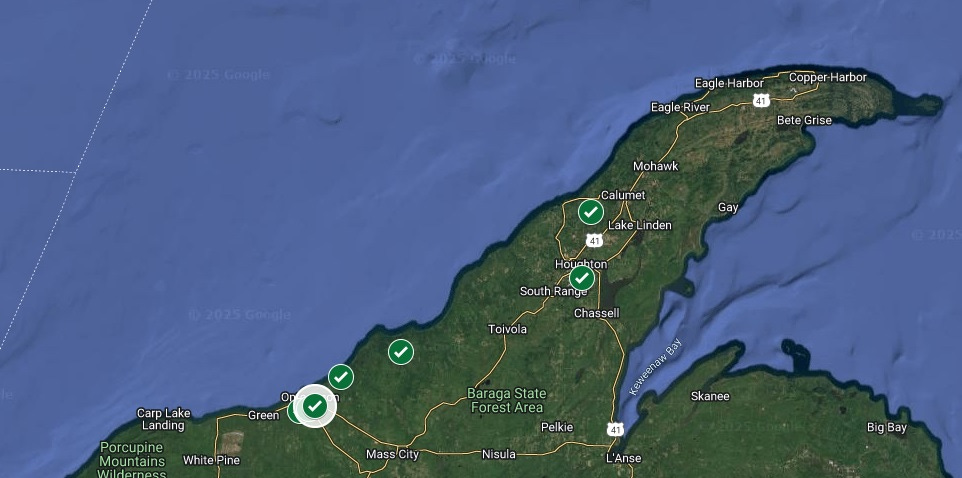Shore Report checked out a different shore in March. We hiked the Seven Sisters chalk cliffs on the south coast of Great Britain. 10 out of 10… would recommend. — Image © John Degen
We thought we’d finished with elections for a little bit, but it was not to be. it seems like as soon as we got the provincial election put to bed, we entered a federal election cycle. The vote is on April 28th, and the North Shore’s full slate of candidates can be found in this issue.
Jobs Coming to Espanola?
Shuttered Domtar pulp and paper mill sold to BMI Group
BMI’s Veldman brothers shaking hands with Espanola Mayor Doug Gervais and local MPP Bill Rosenberg. — image supplied.
In an April 10th Facebook posting, Algoma-Manitoulin MPP Bill Rosenberg announced the former Domtar facility in Espanola has been sold.
“Great news, a purchase agreement has been signed between BMI Group and Domtar in Espanola, congratulations to all parties involved, the future looks bright.”
Further reporting in My Algoma Manitoulin Now suggests the sales agreement includes the hydroelectric plant and dam, with BMI intending to maintain that resource and continue feeding the grid with it.
In a CBC report, BMI’s CEO Paul Veldman indicates that the acquired facility will provide local jobs, but that the 450 jobs lost when the plant was shut by Domtar might not all be returning. It is also unclear at this time just what will be manufactured at the facility, though Veldman indicates they intend to work with local wood providers to process forest products.
Thessalon Main Street Transformed
New & expanded businesses and services herald a season of change
Click play to see a short video tour of changes on Thessalon’s Main Street.
Shore Report took a walk along the North Shore town of Thessalon’s very sunny Main Street recently, taking in a LOT of positive changes for this little hamlet after a hard winter.
New MPP (and former Thessalon mayor) Bill Rosenberg has set up his constituency headquarters just steps from his old digs at the Town Office.
Finding the Algoma-Manitoulin MPP will be easy for Thessalon residents — Image © Shore Report
Rosenberg was in the riding, and spoke with Shore Report briefly about the big job he’s taken on. He’s been assigned some hefty legislative roles as Parliamentary Assistant to the Minister of Agriculture, Food and Agribusiness, and Parliamentary Assistant to the President of the Treasury Board.
He noted how busy he’ll be kept representing a riding that is over 109,000 square kilometers in size. We’ll let him get his feet under him for a bit, and then we hope to sit down and have a longer chat.
The Roasted Bean’s interior features local memorabilia, comfy furniture, and a striking mural. — Image © Shore Report
April 10th was the grand opening of The Roasted Bean café, which transformed the former Creative Basket quilt and knitting shop space into what will surely become a brunch and coffee destination for folks from all around the region. The Roasted Bean is the sister shop to Bruce Mines’ Copper Bean, on Highway 17. Shore Report can attest to the deliciousness of both the lattés and the butter tarts. The Creative Basket moved just up the road a bit into a larger location, expanding their inventory and offerings.
Local quilters and knitters needn’t worry. The Creative Basket is bigger and better than ever. — Image © Shore Report
And finally, further along Main Street, beside the renovated Kosmos Pizza, we ran into tattoo artist, Raven, who with her wife has recently moved to Thessalon and opened not one… not two… but three new Main Street businesses. Along with her Tattoos by Raven studio, Raven is also providing a pet foods and supplies outlet, and Morwood Studio, a spiritual retail space full of crystals, sage and Tarot (readings available!).
Your one-stop shop for spirituality gear, tattoos, and pet supplies! — Image © Shore Report
Raven notes that her tattoo studio is open for bookings now, and May 1st will be the grand opening for both the pet supplies and Morwood Studio.
Thessalon has long been a retail destination for the North Shore, and even more so now. Businesses old and new are the heart of the community.
Advertisement
Read the North Shore… at Sudbury’s own Latitude 46 Books
"I loved spending time in Kim Fahner's northeastern Ontario of the 1920s and 30s, brought vividly to life with her poet's pen in her debut novel The Donoghue Girl.”
—Lauren Carter, author of Places Like These
Ontario Government and Courts Tussle Over Safe Injection Sites
Sudbury and Sault Ste. Marie Hart Hubs planned
Sault Ste Marie Mayor, Matthew Shoemaker at HART Hub announcement — image courtesy the mayor’s Facebook page
Canadian Press (CP) journalist Liam Casey reports an Ontario judge issued an injunction on the immediate closure of supervised drug consumption sites across the province, but that most sites still chose to shutter on April 1st in preparation for transformation into homelessness and addiction recovery treatment (HART) Hubs. According to a Health ministry representative quoted in the report, start-up funding has been delivered, and that nine sites provincewide are official open as of April 1.
According to CP, supervised consumption site administrators believed that taking advantage of the court’s recent temporary stay would jeopardize HART Hub conversion funding, and that this was the impetus to close despite the injunction. Ontario’s new HART Hubs expressly do NOT offer supervised consumption as part of their services.
Image courtesy The Neighbourhood Group.
At least one Toronto supervised consumption site, in the downtown Kensington Market neighbourhood, remains open. Run by The Neighbourhood Group, it relies on donations for its funding, not on the province.
North Shore communities Sault Ste. Marie and Sudbury have both been awarded HART Hub funding. Both municipal governments had previously struggled to provide services to those in need locally, with a Sudbury supervised consumption site closing in 2024 and a proposed Sault initiative unable to secure funding. New provincial funding, even with restrictions, is therefore very welcome. However, an earlier report from CBC Sudbury’s Aya Dufour indicates that northern HART Hub administrators were still unsure of their funding as late as March 26th.
Since neither Sudbury nor Sault Ste. Marie are engaged in converting an active supervised consumption facility to a HART Hub, they were not part of the April 1 timeline.
Shore Report will continue to monitor developments in this story.
Prices, Tariffs, and Sovereignty
The North Shore enters the "elbows up" election
Centre Block, Parliament Hill. — Image © John Degen, 2019.
With Governor General Mary Simon’s dissolving of Parliament on March 23rd, Canada has entered a federal election period to be decided with a vote on April 28th. Shore Report has previously reported on the loss of one North Shore riding in the last boundary shuffle, and will focus on three ridings covering the entirety of Lake Huron’s north shore.
According to a CBC report by Martha Dillman, each of our federal ridings has a slate of declared candidates. With the loss of the Algoma—Manitoulin—Kapuskasing riding and its longtime NDP MP Carol Hughes, the North Shore right now is uniformly red and represented by government-side Liberal MPs. Challengers for these seats include a former Police Chief (Hugh Stevenson, Sault Ste. Marie—Algoma), a CUPE National Health and Safety Representative (Andréane Chénier, Sudbury East—Manitoulin—Nickel Belt), and an Army Reservist and Professional Engineer in the resource industry (Nicholas Bonderoff, Sudbury).
The full list of candidates* to date are:
Sault Ste. Marie—Algoma:
Liberal Party of Canada: Terry Sheehan (sitting MP)
Conservative Party of Canada: Hugh Stevenson
New Democratic Party: Laura Mayer
Left to right - Sheehan, Stevenson, and Mayer. Images courtesy the campaigns.
Sudbury East—Manitoulin—Nickel Belt:
Liberal Party of Canada: Marc Serré (sitting MP)
Conservative Party of Canada: Jim Belanger
New Democratic Party: Andréane Chénier
Left to right - Serré, Belanger, and Chénier. Images courtesy the campaigns.
Sudbury:
Liberal Party of Canada: Viviane Lapointe (sitting MP)
Conservative Party of Canada: Ian Symington
New Democratic Party: Nadia Verrelli
People's Party of Canada: Nicholas Bonderoff
Left to right - Lapointe, Symington, Verrelli, and Bonderoff. Images courtesy the campaigns.
Shore Report hopes to conduct an exit interview with retiring Algoma—Manitoulin—Kapuskasing MP, Carol Hughes. Hughes, originally elected in 2008, has seen the NDP hold Algoma—Manitoulin—Kapuskasing through four subsequent elections. She and all other North Shore MPs were strongly opposed to the redistricting that saw the loss of Algoma—Manitoulin—Kapuskasing.
Retiring MP, Carol Hughes. Image courtesy House of Commons.
Hughes represented the North Shore’s only completely non-urban riding, and has expressed worries that rural and remote voters will no longer be well-represented by the electoral map.
Stayed tuned for more election coverage.
*Please note, the People's Party of Canada had candidates in all three ridings earlier on, but they appear to have dropped from the races in Sault Ste. Marie—Algoma and Sudbury East—Manitoulin—Nickel Belt.
Advertisement
Sudbury’s Urban Forest? There’s a Plan for That.
Formerly deforested North Shore city now has 33% canopy cover
Bailey Chabot, Sudbury’s Senior Planner, Strategic and Environmental Initiatives, talking trees before Council. — image courtesy GSCC
At a March 25 meeting, Greater Sudbury City Council approved the city’s Urban Forest Master Plan, which will promote the health and growth of tree cover in formerly deforested Sudbury into 2050. Urban forest cover is recognized to assist with air quality & temperature mitigation, traffic calming, property values, carbon storage, storm-water runoff, urban biodiversity, and the general well-being of urban residents.
Presented to Council by Senior Planner, Strategic and Environmental Initiatives, Bailey Chabot, the Master Plan includes already good news about Sudbury’s urban forest. According to Chabot, 86% of Sudbury’s current canopy is in very good to good health, and the 33% canopy cover in the city actually places it ahead of famously forested Canadian urban centers like Ottawa, Toronto, and Vancouver.
A slide from Chabot’s Council presentation. — image courtesy GSCC
GSCC’s online wrap up notes:
“The vision for 2050 is to have a diverse and healthy urban forest that supports ecological and social well-being, and the master plan includes 15 key recommendations to get there. The Urban Forest Working Group has created an implementation strategy for the first year and will return with annual updates on the plan’s progress.”
Thessalon First Nation Legal Troubles Detailed in Local Media
Former executive director suing for wrongful dismissal
Image courtesy Thessalon First Nation Facebook page.
SooToday journalist James Hopkin has been reporting on recent legal troubles at Thessalon First Nation (TFN). A March 14 story indicates former TFN executive director Lesley Boulrice filed a civil claim seeking $477,713 in lost salary and benefits (along with court costs). Boulrice is reportedly alleging termination without cause.
A later story details information from TFN’s “statement of defence,’ which reportedly claims the former employee “engaged in serious misconduct and abused their authority when they reworked their own employment contract to score a lucrative cash windfall upon termination.” According to the story, TFN has retained Toronto law firm Kastner Ko LLP for its defence.
Hopkin reports “Thessalon First Nation contends Boulrice exploited Chief Joseph Wabigwan by manipulating him into signing a new employment agreement “during a period when he was ill and confined to bed rest” last year.
It would appear TFN’s legal troubles ramped up after the 2023 band elections for chief and council. A January 2024 story by Hopkin detailed a Federal Court fight concerning the community’s election appeal committee. A civil suit from yet another former director closely followed.
Shore Report thanks James Hopkin for his hard work following these stories, and will continue to watch coverage carefully.
Cougar Spotters Head to Bruce Mines
YouTubers looking for evidence of big cats on the North Shore
Video still from Wild MOUNTAIN LIONS Are BACK In Southern Ontario!
A YouTube series called Mountain Lions of Urban Ontario is intent on proving that the long-disappeared cougar has returned to the province in significant numbers. Fishing Urban Ontario, the group producing the video series, will be heading to Bruce Mines soon to create video content of potential big cat evidence. Locals with cougar sightings are encouraged to contact Fishing Urban Ontario here.
According to the website ecoissues.ca, the eastern cougar (Puma concolor) “was officially declared extinct in 2011 by the Committee on the Status of Endangered Wildlife in Canada (COSEWIC).” The COSEWIC site itself contains a 1998 status report on the eastern cougar, listing it as “indeterminate” and noting the unreliability of sightings:
“Distribution of cougar sightings in eastern Canada now extends much further north than historic limits in Ontario and Québec but the taxonomic identity of all but one of these animals is undetermined. Whether this northward extension is real or only the result of increasing accessibility to human observers is unknown.”
While big cats like cougars are known to have large territories and depend on a range of prey sizes and types, the North American population of cougars is officially western and southern, after eastern cougars were eliminated by over-hunting. But Fishing Urban Ontario says that accepted fact is wrong, and they aim to prove it by finding and recording evidence of cougar cubs in the wild.
Despite individual cougars being reliably spotted in Sudbury, Thunder Bay, and even as far south as Barrie, the official explanation is that these cats are escaped exotic pets or transient individuals, and are not evidence of a significant population. The Ontario Ministry of Natural Resources lists the cougar as a species of “special concern,” which is in itself recognition that they are indeed here, though their numbers are unknown.
Image courtesy Google Maps.
Fishing Urban Ontario’s Google Map of cougar sightings stops at the Ontario border, but confirmed sightings of cougar cubs are not far away, on the south shore of Lake Superior near Porcupine Mountains Wilderness State Park. Given that wildlife are not known to respect international borders, chances are reasonable some of the American cougars have crossed north.
The Quick Facts listed on the MNR cougar page should help anyone interested in, or concerned about, meeting a cougar while out in the north country:
Cougars rarely chase their prey. They are masters of camouflage and will slowly and silently slink forward and then pounce. Cougars usually hunt at night.
Cougars are shy and normally avoid humans. If you see a Cougar, stay calm, remain standing, and make yourself look large by holding your arms above your head. You should immediately back away slowly and leave the area. If the animal is aggressive, throw objects at it – never run.
Cougars are excellent swimmers and climbers and can jump more than six metres.
Female Cougars have two to four kittens every two to four years. The family stays close together for up to two years while the young learn how to hunt.
Paramedic Service Stepped up During Recent North Shore Cyber Attack
Code Grey saw ambulances rerouted; extended partner network tapped
Thank a paramedic today. Image courtesy Algoma District Services Administration Board.
On Monday, March 24th, the North Shore Health Network (NSHN) announced on its website it was “back online and actively recovering from a cyber incident that began on Wednesday March 19, 2025.”
As was widely reported, the incident resulted in a temporary loss of internet access, and no access to the regional Electronic Medical Record (EMR) as all three NSHN locations (Blind River, Thessalon, & Richards Landing – Matthews) were isolated from the Northeast network and the eHealth Ontario network. With a breach into the online system, it was necessary to shut down pathways to wider networks to make sure whoever had broken security could go no further.
Shore Report contacted NSHN CEO Tim Vine for details of how the network fixed the problem, ensured patient safety, and maintained service during a very tricky time.
Tim Vine, President & CEO of the North Shore Health Network. Image courtesy NSHN.
“We have done immediate remediation on our networks,” Vine said, “with the support of the regional IT group, Health Science North, and our third-party cyber security provider. We are currently doing a full after-action/debrief process to identify further improvements. I am sure we, along with the region, will have helpful learnings from this to improve security and response for future events.”
While emergency departments remained open to the public during the offline period, what was not immediately apparent was a resulting ambulance service disruption to the local ERs.
Vine explained that patients arriving by ambulance tend to be the most acutely ill, and access to online diagnostics and readings is paramount. With those tools temporarily out of reach for NSHN, ambulance patients were shifted to facilities that had access to crucial files.
“Unfortunately for a short period during the Code Grey we needed to go on ambulance by-pass at all three sites,” Vine explained. “We took the hard decision to go on by-pass until we could once again provide safe care to patients. Once we found an alternative approach, we were able to lift the by-pass.”
According to Vine, neighbouring hospitals in Elliot Lake, Espanola, and Sault Ste. Marie stepped in to take ambulance patients, and “proved to be exemplary partners.”
91 km route between Thessalon’s NSHN site and Sault Area Hospital. Image courtesy Bing Maps.
Obviously, increased travel time by ambulance, especially on wintry highways and roads, is a strain on service delivery. It would appear Algoma District Paramedic Services responded to the temporary bypass order efficiently and skillfully, delivering to partner hospitals while the NSHN sites remained offline.
With approximately 48,000 sq. kms in their coverage region, no access to centrally located facilities would have greatly increased both drive times and strain on paramedics. It would also have meant an ambulance patient from the Thessalon area, for instance, would have to travel at least an hour to Sault Ste. Marie for care, instead of the relatively short ride to the Thessalon NSHN site.
Cyber attacks on healthcare infrastructure are, sadly, not unheard-of in Canada. A 2023 report from Global News notes “data breaches and ransomware, [have] become increasingly common in the country.”
Vine assures NSHN patients “there was no data loss, corruption, or privacy violation during the intrusion on our network.”
It would also appear this was not a ransomware attack.
The recent Ontario Health Coalition annual report reminds us that “Ontario’s public hospitals and public health care system are now funded at the lowest rate per person in Canada.” Given the ongoing focus on medical access in the province, and especially in rural and remote communities, North Shore residents don’t need yet another worry. Ontario Health has developed a coordinated response model for cyber security in health facilities. Hopefully, the NSHN debrief on this incident will help strengthen the system.
“I want to thank the patients, residents, and clients we serve for their patience,” Vine said, “NSHN staff for their perseverance, and the region for their support. It has reassured me that NSHN has a great team, and that we have come a long way in regional inter-hospital cooperation.”
Shore Report Featured in CBC Coverage of Local Media
Dedicated amateur reporters highlighted by pro Aya Dufour
Greg Sutherland reporting roadside on highway conditions, weather, and gas prices. — Image courtesy Greg Sutherland’s Facebook page.
A March 11 online story from CBC Sudbury featured three Northern Ontario news outlets that don’t follow the traditional media script, including this very outlet you’re reading right now.
Local journalist Aya Dufour interviewed Greg Sutherland from Birch Island’s General Store and Gas about his charming and highly popular weather and traffic reports from roadside at the gas station.
Dufour also spoke with miner Daniel Pegg whose Northern Ontario Information Station Facebook page many Shore Report readers will already be aware of.
Image courtesy CBC Sudbury
Finally, Dufour interviewed your humble correspondent about the impetus and driving force for Shore Report itself. She writes:
“Degen's Shore Report is still a work in progress, with a small but loyal audience. It's a crowd funded business model, and Degen said even if the project never becomes viable, he'll stay committed to it as a service to his community.”
Shore Report staff on assignment (looking for cougars?). — Image © John Degen
Shore Report assures our readers that we will indeed continue highlighting and creating excellent coverage from Lake Huron’s North Shore, and we thank our “small but loyal audience.”
Shore Report is a reader-supported publication. To receive new posts directly, and support our work, become a free or paid subscriber.






























